 Backend Development
Backend Development
 Python Tutorial
Python Tutorial
 Pandas Tips: Basic DataFrame Operations and Null Value Filling
Pandas Tips: Basic DataFrame Operations and Null Value Filling
Pandas Tips: Basic DataFrame Operations and Null Value Filling

Related learning recommendations: python tutorial
pandas data processing In the fourth article of the topic, let’s talk about indexes in DataFrame.
In the previous article, we introduced the use of some commonly used indexes in the DataFrame data structure, such as iloc, loc, logical indexes, etc. In today's article, let's take a look at somebasic operations of DataFrame.
Data alignment
We can calculate the sum of two DataFrames,pandas will automatically Two DataFrames perform data alignment. If the data does not match, it will be set to Nan (not a number).
First we create two DataFrames:import numpy as npimport pandas as pddf1 = pd.DataFrame(np.arange(9).reshape((3, 3)), columns=list('abc'), index=['1', '2', '3'])df2 = pd.DataFrame(np.arange(12).reshape((4, 3)), columns=list('abd'), index=['2', '3', '4', '5'])复制代码create the DataFrame through the numpy array, and then specify the index and columns. , this should be considered a very basic usage.
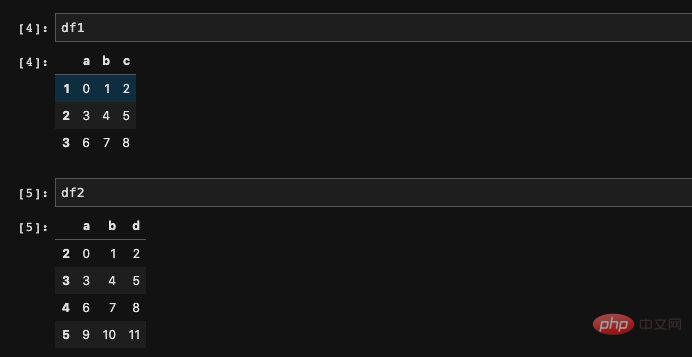

any position that does not appear in both DataFrames will be set to Nan. This actually makes sense. In fact, not just addition, we can calculate the four arithmetic operations of addition, subtraction, multiplication and division of two DataFrames. If you calculate the division of two DataFrames, in addition to the data that does not correspond to it will be set to Nan, The act of dividing by zero will also lead to the occurrence of outliers (may not necessarily be Nan, but is inf).
fill_value
If we are going to operate on two DataFrames, then of course we don’t want null values to appear . At this time, we need to fill in the null values. If we directly use operators to perform operations, we cannot pass parameters for filling. At this time, we need to use thearithmetic method provided for us in the DataFrame.
There are several commonly used operators in DataFrame: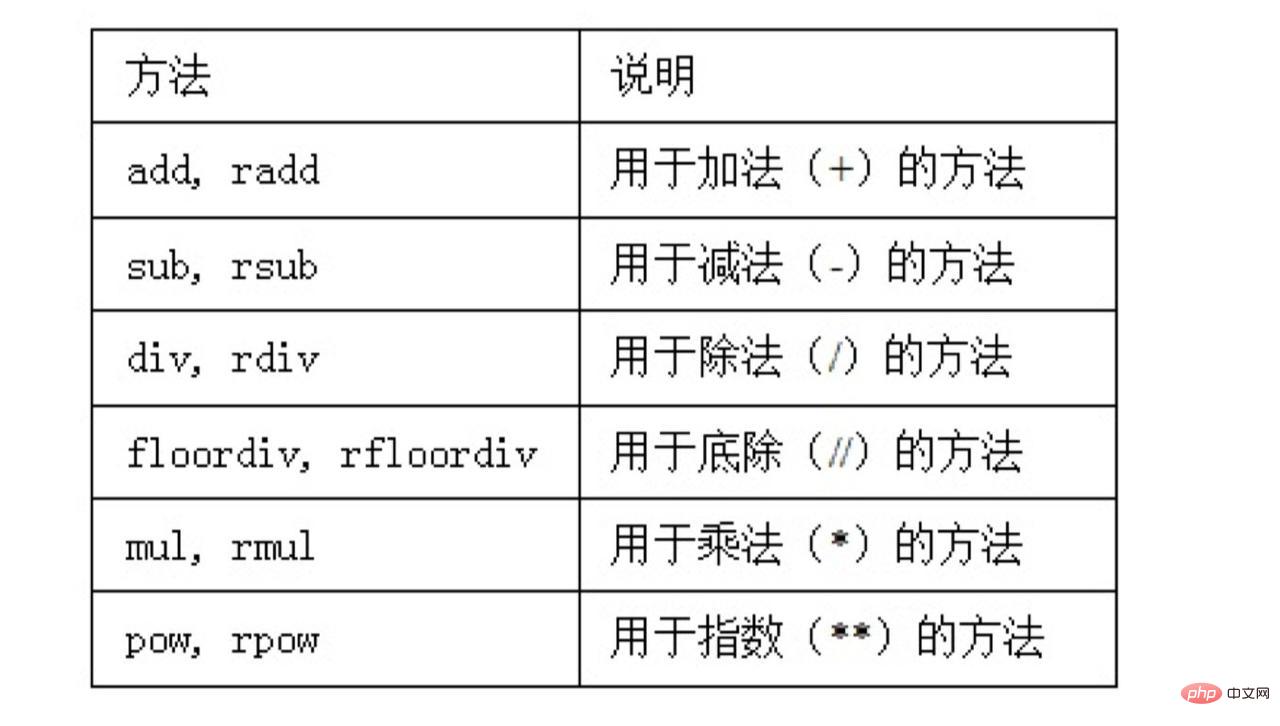
We all understand add, sub, and p very well, so what do the radd and rsub methods here mean? Why is there an r in front?
It seems confusing, but to put it bluntly, radd is used to flip parameters. For example, if we want to get the reciprocal of all elements in the DataFrame, we can write it as 1/df. Since 1 itself is not a DataFrame, we cannot use 1 to call methods in the DataFrame, and we cannot pass parameters. In order to solve this situation, wecan write 1/df as df.rp(1), so we can pass parameters in it.

Since division by zero occurs during the division calculation, we get an inf, which represents infinity.
We can pass in a fill_value parameter in the add and p methods. This parameter can fill in the case of missing values on one side before calculation. That is to say, positions that are missing in only one DataFrame will be replaced with the value we specify. If it is missing in both DataFrames, it will still be Nan.
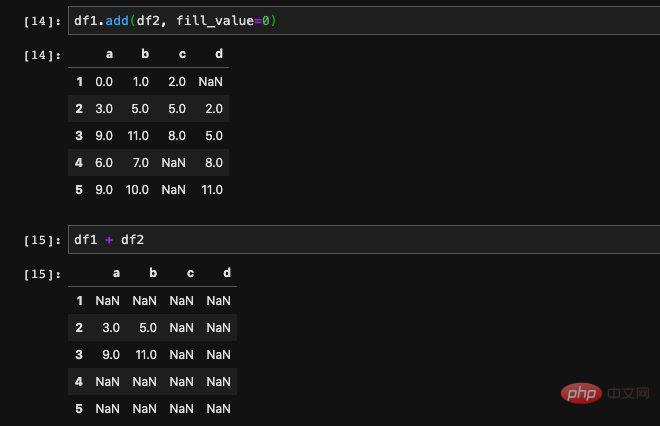
We can compare the results and find that the positions of (1, d), (4, c) and (5, c) after addition are all Nan , because these positions in the two DataFrames df1 and df2 are empty values, so they are not filled.
#fill_value This parameter appears in many APIs, such as reindex, etc. The usage is the same. We can pay attention to it when checking the API documentation.
So what should we do with this kind of empty value that still appears after filling? Can I only manually find these locations and fill them in? Of course it is unrealistic. Pandas also provides us with an API that specifically solves null values.
null value api
#Before filling the null value, the first thing we have to do is find the null value. To solve this problem, we have the isna API, which will return a bool DataFrame. Each position in the DataFrame indicates whether the corresponding position of the original DataFrame is a null value.
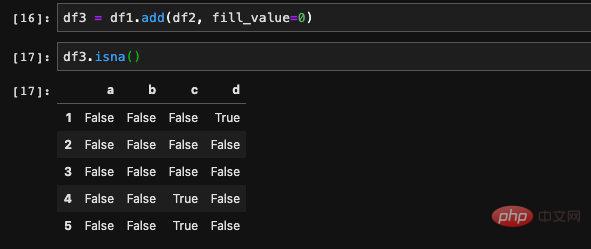
dropna
Of course, just finding out whether it is a null value is definitely not enough, we Sometimes we hope that null values will not appear. At this time, we can choose drop the null values. For this situation, we can use the dropna method in DataFrame.

We found that after using dropna, rows with null values were discarded. Only rows without null values are retained. Sometimes we want to discard the columns instead of rows. At this time, we can control it by passing in the axis parameter.
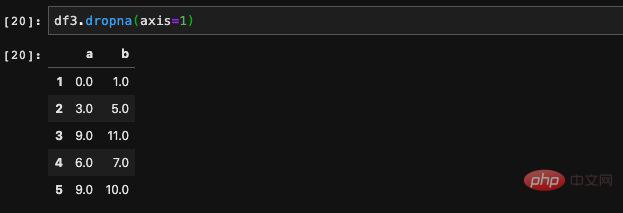
In this way, what we get is a column that does not contain null values. In addition to controlling the rows and columns, we can also control the strictness of executing drop . We can judge by the how parameter. How supports two values to be passed in, one is 'all' and the other is 'any'. All means that it will be discarded only when a certain row or column is all null values, and corresponding to any, it will be discarded as long as null values appear. If it is not filled in by default, it is considered to be any. Under normal circumstances, we do not use this parameter, and it is enough to have an impression.
fillna
In addition to dropping data containing null values, pandas can also be used Fill empty values, in fact this is also the most commonly used method.
We can simply pass in a specific value for filling:

fillna will return a new DataFrame, All Nan values will be replaced with the values we specify. If we do not want it to return a new DataFrame, but directly modify the original data, we can use the inplace parameter to indicate that this is an inplace operation, then pandas will modify the original DataFrame.
df3.fillna(3, inplace=True)复制代码
除了填充具体的值以外,我们也可以和一些计算结合起来算出来应该填充的值。比如说我们可以计算出某一列的均值、最大值、最小值等各种计算来填充。fillna这个函数不仅可以使用在DataFrame上,也可以使用在Series上,所以我们可以针对DataFrame中的某一列或者是某些列进行填充:
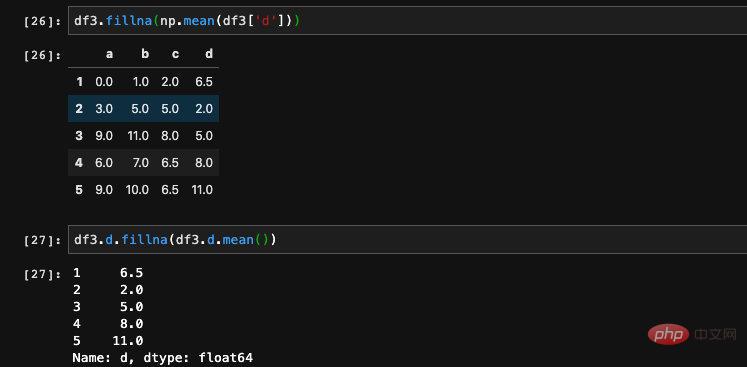
除了可以计算出均值、最大最小值等各种值来进行填充之外,还可以指定使用缺失值的前一行或者是后一行的值来填充。实现这个功能需要用到method这个参数,它有两个接收值,ffill表示用前一行的值来进行填充,bfill表示使用后一行的值填充。
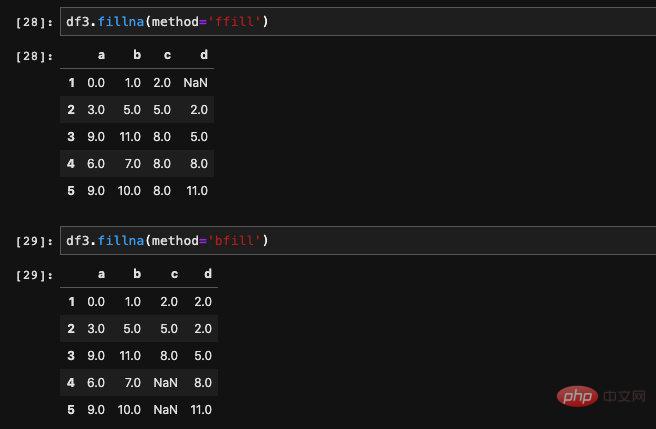
我们可以看到,当我们使用ffill填充的时候,对于第一行的数据来说由于它没有前一行了,所以它的Nan会被保留。同样当我们使用bfill的时候,最后一行也无法填充。
总结
今天的文章当中我们主要介绍了DataFrame的一些基本运算,比如最基础的四则运算。在进行四则运算的时候由于DataFrame之间可能存在行列索引不能对齐的情况,这样计算得到的结果会出现空值,所以我们需要对空值进行处理。我们可以在进行计算的时候通过传入fill_value进行填充,也可以在计算之后对结果进行fillna填充。
在实际的运用当中,我们一般很少会直接对两个DataFrame进行加减运算,但是DataFrame中出现空置是家常便饭的事情。因此对于空值的填充和处理非常重要,可以说是学习中的重点,大家千万注意。
想了解更多编程学习,敬请关注php培训栏目!
The above is the detailed content of Pandas Tips: Basic DataFrame Operations and Null Value Filling. For more information, please follow other related articles on the PHP Chinese website!

Hot AI Tools

Undresser.AI Undress
AI-powered app for creating realistic nude photos

AI Clothes Remover
Online AI tool for removing clothes from photos.

Undress AI Tool
Undress images for free

Clothoff.io
AI clothes remover

Video Face Swap
Swap faces in any video effortlessly with our completely free AI face swap tool!

Hot Article

Hot Tools

Notepad++7.3.1
Easy-to-use and free code editor

SublimeText3 Chinese version
Chinese version, very easy to use

Zend Studio 13.0.1
Powerful PHP integrated development environment

Dreamweaver CS6
Visual web development tools

SublimeText3 Mac version
God-level code editing software (SublimeText3)

Hot Topics
 1386
1386
 52
52
 Can vs code run in Windows 8
Apr 15, 2025 pm 07:24 PM
Can vs code run in Windows 8
Apr 15, 2025 pm 07:24 PM
VS Code can run on Windows 8, but the experience may not be great. First make sure the system has been updated to the latest patch, then download the VS Code installation package that matches the system architecture and install it as prompted. After installation, be aware that some extensions may be incompatible with Windows 8 and need to look for alternative extensions or use newer Windows systems in a virtual machine. Install the necessary extensions to check whether they work properly. Although VS Code is feasible on Windows 8, it is recommended to upgrade to a newer Windows system for a better development experience and security.
 How to run programs in terminal vscode
Apr 15, 2025 pm 06:42 PM
How to run programs in terminal vscode
Apr 15, 2025 pm 06:42 PM
In VS Code, you can run the program in the terminal through the following steps: Prepare the code and open the integrated terminal to ensure that the code directory is consistent with the terminal working directory. Select the run command according to the programming language (such as Python's python your_file_name.py) to check whether it runs successfully and resolve errors. Use the debugger to improve debugging efficiency.
 Can visual studio code be used in python
Apr 15, 2025 pm 08:18 PM
Can visual studio code be used in python
Apr 15, 2025 pm 08:18 PM
VS Code can be used to write Python and provides many features that make it an ideal tool for developing Python applications. It allows users to: install Python extensions to get functions such as code completion, syntax highlighting, and debugging. Use the debugger to track code step by step, find and fix errors. Integrate Git for version control. Use code formatting tools to maintain code consistency. Use the Linting tool to spot potential problems ahead of time.
 Is the vscode extension malicious?
Apr 15, 2025 pm 07:57 PM
Is the vscode extension malicious?
Apr 15, 2025 pm 07:57 PM
VS Code extensions pose malicious risks, such as hiding malicious code, exploiting vulnerabilities, and masturbating as legitimate extensions. Methods to identify malicious extensions include: checking publishers, reading comments, checking code, and installing with caution. Security measures also include: security awareness, good habits, regular updates and antivirus software.
 Python: Automation, Scripting, and Task Management
Apr 16, 2025 am 12:14 AM
Python: Automation, Scripting, and Task Management
Apr 16, 2025 am 12:14 AM
Python excels in automation, scripting, and task management. 1) Automation: File backup is realized through standard libraries such as os and shutil. 2) Script writing: Use the psutil library to monitor system resources. 3) Task management: Use the schedule library to schedule tasks. Python's ease of use and rich library support makes it the preferred tool in these areas.
 What is vscode What is vscode for?
Apr 15, 2025 pm 06:45 PM
What is vscode What is vscode for?
Apr 15, 2025 pm 06:45 PM
VS Code is the full name Visual Studio Code, which is a free and open source cross-platform code editor and development environment developed by Microsoft. It supports a wide range of programming languages and provides syntax highlighting, code automatic completion, code snippets and smart prompts to improve development efficiency. Through a rich extension ecosystem, users can add extensions to specific needs and languages, such as debuggers, code formatting tools, and Git integrations. VS Code also includes an intuitive debugger that helps quickly find and resolve bugs in your code.
 Golang vs. Python: Concurrency and Multithreading
Apr 17, 2025 am 12:20 AM
Golang vs. Python: Concurrency and Multithreading
Apr 17, 2025 am 12:20 AM
Golang is more suitable for high concurrency tasks, while Python has more advantages in flexibility. 1.Golang efficiently handles concurrency through goroutine and channel. 2. Python relies on threading and asyncio, which is affected by GIL, but provides multiple concurrency methods. The choice should be based on specific needs.
 Can visual studio code run python
Apr 15, 2025 pm 08:00 PM
Can visual studio code run python
Apr 15, 2025 pm 08:00 PM
VS Code not only can run Python, but also provides powerful functions, including: automatically identifying Python files after installing Python extensions, providing functions such as code completion, syntax highlighting, and debugging. Relying on the installed Python environment, extensions act as bridge connection editing and Python environment. The debugging functions include setting breakpoints, step-by-step debugging, viewing variable values, and improving debugging efficiency. The integrated terminal supports running complex commands such as unit testing and package management. Supports extended configuration and enhances features such as code formatting, analysis and version control.



